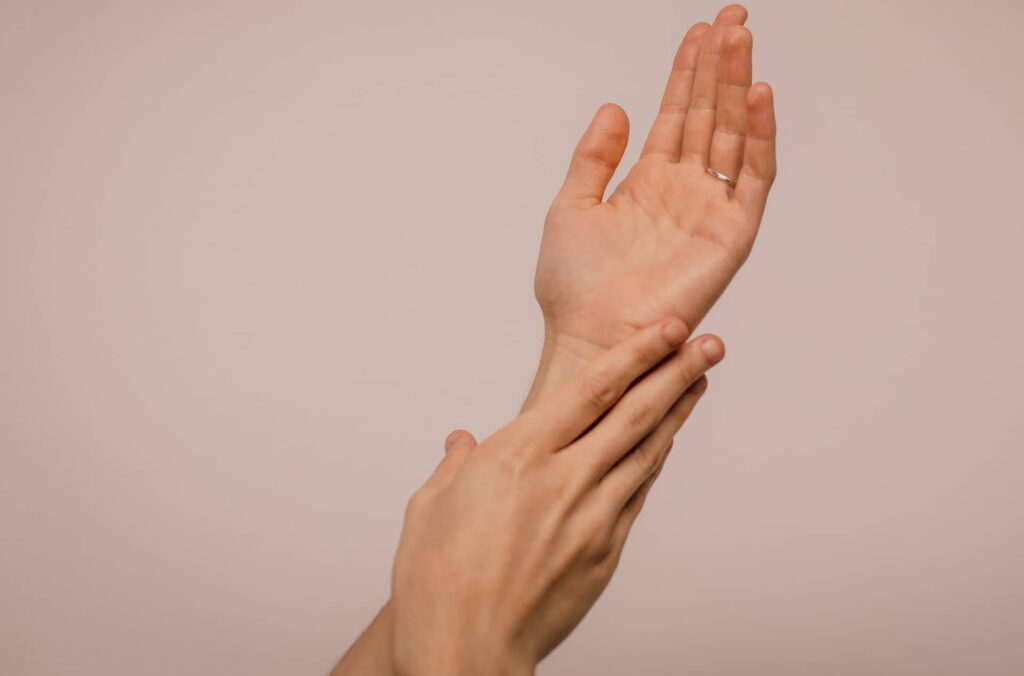The bass guitar is a physically demanding instrument, due to its long neck and thick strings. Thus, playing it incorrectly or excessively can result in wrist pains in your fretting hand. So, how do you avoid injuries, and why exactly are your wrists hurting after playing the bass?
Wrist pain as a result of playing the bass is generally caused by bending of the wrist while playing, lack of warmup, improper posture, or a poorly set up bass. Other reasons include too low strap height, improper breathing, a stressed demeanor, or underlying health issues.
Having experienced wrist pain from playing the bass in the past, I know how frustrating it can be. Thus, I decided to write this article to help you play without any unneeded pain.
I will help you identify some possible causes for why you might be experiencing wrist pain. I will also provide you with some solutions for how to make your wrists stop hurting from playing the bass. Lastly, I will show you at what point you should speak with a medical professional if the issue persists.
Is it normal for your wrist to hurt after playing bass?
Your wrist should not be hurting after playing the bass guitar. The only case where this is expected is when a complete beginner plays for an extended amount of time. Extended wrist pain is generally a result of improper technique, and can lead to lasting and obstructing pain if left untreated.
I, like many others bassists have experienced wrist pains in the past. This is not uncommon when playing for too long when just starting out. However, the pain in your wrist should not persist if you are playing with the right type of technique.
It is more common to experience wrist pain if you are pressing strings down harder than needed. Another possible reason is that your bass has too high action. Both are exhausting for your hand and can lead to wrist pain. Adjust your action lower, and be mindful of how hard you fret strings if you suspect this might be the case.
Wrist pain is also one of many reasons it’s good a idea to take bass lessons, especially if you are a beginner. Fixing your technique early on stops you from developing habits that could hurt your hands. While the cost of lessons is a deterrent for many, the long-term benefits greatly outweigh it. This is especially true if you are already experiencing wrist pains.
Most importantly, you should not be playing bass when experiencing wrist pain. “Fighting through it” or trying to fix your playing when you are already hurting, will only slow down the recovery of your hands.

How do I make my wrists not hurt when playing bass?
To avoid wrist pain while playing the bass, make sure to properly warm-up before playing. Your posture and hands need to be kept relaxed and your wrist should be kept straight. If you still experience pain, wear your bass higher up on your chest and lower the action and tension of your strings.
Here are some of my key tips for stopping your wrist from hurting while playing the bass:
Warm-up: You should always warm-up before rehearsing or performing. Nowadays I do this by playing scales and various finger exercises. This not only warms the hands up but also adjusts them to playing bass. Another great way to warm your hands up is to use heat packs or a Gripmaster. I go into detail about these options in my article on playing bass with cold hands.
Straight wrist: Keep the wrist of your fretting hand straight when you are playing the bass. You should never grip the neck at an unnatural or contorted angle. If you notice yourself doing this, make it your number one priority to change this habit. It will lead to more pain down the road if you continue playing with a bent wrist.
Strap height: If you are experiencing wrist pain, it might help to strap your bass higher up on your chest. This way you won’t have to stretch your hands as far to reach the notes you want to play.
Support splint: A support splint provides your wrist with support It does this by keeping your wrist and thumb in a proper position. Thus it lessens the chance of your wrist hurting when you decide to pick up the bass. Support splints are available on Amazon (click to see current prices). It works great as a preemptive measure for wrist pain, but I do not recommend using it as a substitute for a medical checkup if you are already experiencing frequent or lasting pain.
Breath: Even intermediate bassists make the mistake of holding their breath when they are concentrating. This can indirectly result in hand pains due to tension and not playing with proper technique. Thus, be mindful of your breathing when playing demanding parts, and avoid holding it for unnaturally long.
Posture: The posture of your whole body impacts the strain you are putting on your hands. You will notice this quickly if you try playing with raised shoulders or a puffed chest. Thus, be mindful of keeping your entire body relaxed while playing because all types of tension can have a negative impact on your hands.
Hand stretches: Stretching your hands, wrists, and fingers is helpful for maintaining the health of your hands. This is especially true when playing for extended periods of time. Keep in mind that stretches help prevent wrist pain, but should not be done to heal your hands if you are already experiencing it. You can learn more about ways to stretch your hands at HealthLine.
Seeing a Doctor
I am a bassist, not a doctor. This is not medical advice.
If you are experiencing short-term wrist pain from playing the bass, it can generally be fixed by following the tips above. However, if the pain keeps persisting despite this, there are several reasons for seeing a doctor.
First of all, seeing a doctor about lasting wrist pain as soon as possible is significantly preferable to hoping it passes or continuing to play if you have not been able to fix the issue on your own. Continued subjection to painful playing can lead to last damage that can be hard to treat. It could thus become a major hindrance to your musical goals and decrease the overall quality of your life. A doctor can help you diagnose what is causing the pain, which will be necessary at this point.
Second, your wrist pain could be the result of an existing condition, which could be completely unrelated to the bass. If you have undiagnosed arthritis or carpal tunnel syndrome, a medical professional can assists you in diagnosing and treating these issues. I would be especially mindful of this if you have experienced wrist pains in the past when not playing the bass.
Conclusion
If your wrist hurts after playing the bass, there is most likely something wrong with your technique. The pain could also be a result of how your bass is set up, or be related to an underlying health issue.
For most bassists, following the tips above and adjusting a couple of things will be enough to stop the wrist pain. There are many possible causes, but most of them can easily be fixed.
If these tips do not solve the issue, do not keep playing in a way that hurts your hands. A possible solution for this is to take lessons, as a bass tutor can help you fix your technique. If the pain persists, I recommend seeing a doctor, as continued playing will be painful and can lead to lasting hand issues.
If you are experiencing various forms of pain, you might be playing bass more than you should. To learn more about how much you should practice (depending on what you want to achieve musically), read my guide on How long you should practice bass each day.

